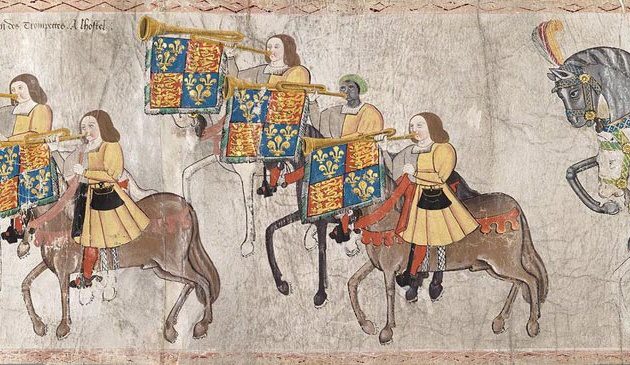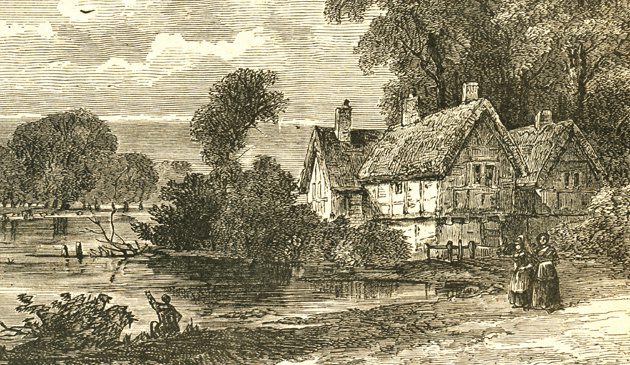Westminster Abbey in the Tudor period

The coronation procession of Anne Boleyn at Westminster Abbey on 31st May 1533, from a drawing by David Roberts. Anne was the second wife of Henry VIII to have a coronation in the abbey, the first being a joint coronation of Henry and Catherine of Aragon in June 1509. Over a period of four days of celebration Anne travelled by barge from Greenwich to the Tower of London, and then from there in a procession to the abbey. None of Henry’s later four wives were given a coronation.
The Tudor period, from the coronation of Henry VII to the funeral of Elizabeth I, was a tumultuous time for religion in England, and particularly so for Westminster Abbey. It began with the addition of a magnificent new chapel that remains one of the highlights of the abbey. It continued with a roller-coaster period during which the institution lurched from being an abbey, to a cathedral, and finally to a collegiate church.
Henry VII was crowned at Westminster Abbey in October 1485 and the new Tudor royal dynasty began. Two years later, his wife, Elizabeth of York, was crowned Queen in the abbey. Her mother, Elizabeth Woodville, widow of Edward IV, took a lease on a house in the grounds of Westminster. It was in the same house, while taking refuge, where she had given birth to the future Edward V, who as a child was then murdered in the Tower of London with his younger brother, what is known as ‘the two princes in the tower’.
Henry had a very weak and dubious claim to the throne, which he had gained in battle, so he looked for ways to legitimise his title. There had been reports of miracles occurring around the grave of Henry’s uncle, Henry VI, who had been deposed in 1461, murdered ten years later in the Tower, buried at Chertsey, and later moved to Windsor. The new King therefore decided to exploit this cult by creating a major shrine of pilgrimage at Westminster Abbey and seeking to have his uncle canonized. There could be nothing better to legitimize his position and increase prestige than being descended from a saint.
Henry commissioned the architect-mason brothers Robert and William Vertue to build a new Lady Chapel to house the shrine of Henry VI. The 13th century Lady Chapel was demolished and the first stone of Henry’s chapel laid in 1503. A vast sum of money was spent, paid for by the King and his mother. Stone was brought from Kent, Reigate, Yorkshire and Caen and in 1509 enough of the chapel had been completed for its consecration to take place.
Henry’s chapel was a work of great beauty in a synthesis of northern Gothic and Italian Renaissance. It is part of a group of royal chapels built in the Perpendicular style around the same period: Eton College chapel; King’s College chapel, Cambridge; and St. George’s chapel, Windsor Castle. Of particular note is the spectacular ornate fan-vaulted and pendant-vaulted ceiling. One hundred and seven figures of saints looked down in judgement, with Henry’s favourite English and Welsh saints in dominant positions. The windows were originally glazed with splendid stained-glass windows by Bernard Flower from the Low Countries, with scenes from the Bible, which served as models for those at King’s College Cambridge. They were later destroyed during the Long Parliament of the 1640s and plain glass is now mostly in its place.
In a sequence of events reminiscent those of 1065, when Edward the Confessor never lived long enough to see the completion of his first great Romanesque Westminster Abbey, Henry died just as the work was completed. A magnificent funeral ceremony took place through the streets of London, stopping for one night at St. Paul’s Cathedral. The idea of the canonization of his uncle died with Henry, thwarted by an unaffordable price from the Pope, and Henry VI’s grave remained at Windsor. In the end it was Henry VII himself who was buried in the chapel, together with his wife Elizabeth of York, in a tomb designed by the Italian Pietro Torrigiani, commissioned by their son, Henry VIII.
The construction of much of the abbey of today had begun under Henry III in the mid-13th century. It was left incomplete at his death and only continued in fits and spurts thereafter. Much of the work was completed in the early 16th century under Abbot John Islip, almost three centuries after it started. It was under him that work on the western towers began. Whereas most of the rebuilding had been continued in the Gothic style of nearly three centuries earlier, the towers were to be of a design of the early 16th century. Work had only reached roof-level when it halted due to the great political and religious convulsions that were to occur in the Reformation. The towers would remain incomplete until the early 18th century.
Islip was a great friend of Thomas Wolsey, a favourite of Henry VIII. When Wolsey was elevated to become a cardinal in 1515 his cardinal’s hat was paraded from Blackheath to Westminster where it rested on the high altar. The following Sunday the service of confirmation of his high dignity took place in the abbey with great ceremony. His failure to persuade the Pope to annul Henry’s marriage to Catherine of Aragon, however, angered the King and was Wolsey’s downfall.
His friendship with the disgraced cardinal undermined Abbot Islip’s position. The abbey was forced to pay an annual bribe to Henry’s chief minister, Thomas Cromwell, and the King appropriated some of the abbey’s land to extend the palace he had confiscated from Wolsey at Whitehall. The abbey’s bell-tower contained a bell of enormous size that was rung at coronations. Henry had it confiscated and remade into cannons. Yet when John Islip died in May 1532 his body was carried from his manor at Neyte (otherwise known as Eye) to the abbey, as crowds lined the road from Chelsea to Westminster. He was the only abbot of Westminster who had prepared for the afterlife by building his own chantry chapel, the Jesus Chapel, and he was buried there. The images of the interior of the abbey in his Funeral Roll are the earliest on record.
Within hours of Islip’s death the Submission of the Clergy passed into law, the first step in the convulsions that were to afflict England during the next quarter century. Both that and the Act of Supremacy, which made Henry head of the Church in England, were passed by Parliament in the abbey’s Chapter House. Islip was succeeded by William Boston from Peterborough, the first outsider to be Abbot of Westminster in over 300 years. But by then England’s monasteries were already being dissolved and every monk, nun and friar evicted. William was to be the last to hold that position at Westminster. It was under his custody that in April 1534 Sir Thomas More was initially imprisoned in the gatehouse of Westminster Abbey before being sent to the Tower of London for refusing to swear to the King’s supremacy. Boston seems a pragmatic man who adapted to each stage of the great changes during his 16 years at Westminster. Not only was he the last abbot of Catholic Westminster but also the first Protestant dean.


